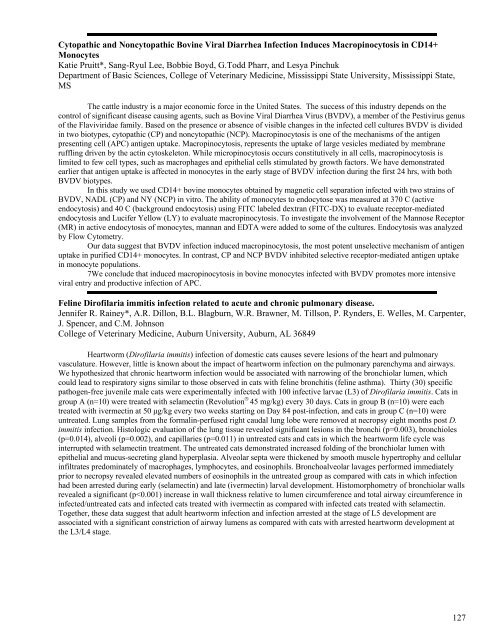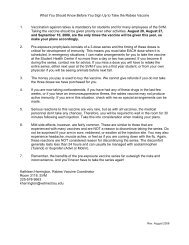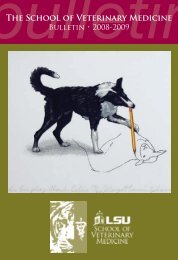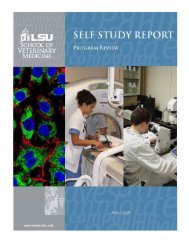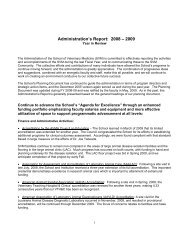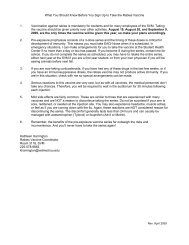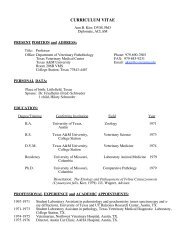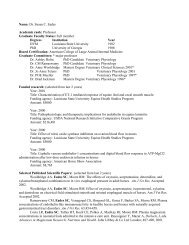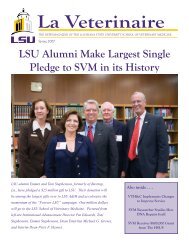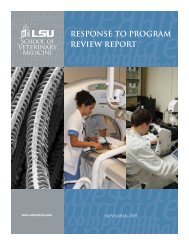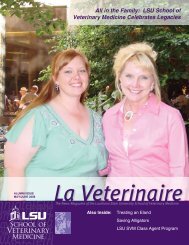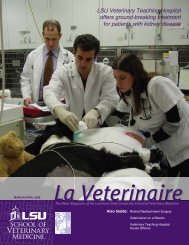purified, viral RNA was extracted and viral segments amplified by RT-PCR technology. The IA/30 H1N1 virus is geneticallyengineered with unique restriction sites in each <strong>of</strong> its 8 individual genes. Therefore, the origin <strong>of</strong> each viral segment can beeasily differentiated.Results: Reassortment occurred in pigs co-infected with the H1N1 and H3N2 viruses. All novel reassortant SIVscontained the wild-type NS-segment from the H1N1 IA/30 and the NP-segment from the modern H3N2 Tx/98 strain. Most <strong>of</strong>the PB2 (avian origin) and NA (human origin) genes (about 90%) originated from the H3N2 Tx/98 strain. The origin <strong>of</strong> theother four genes (PB1, PA, HA, M) are randomly derived from either the H1N1 or H3N2 SIV.Conclusions: The avian–like PB2 and the modern NP genes (H3N2) were preferentially selected into the novelreassortant SIVs. This indicates these two genes and their products might play an important role in the adaptation <strong>of</strong> novelreassortant SIVs. These studies also proved that a functional immunomodulatory NS1 protein (has interferon modulatingabilities) is critical for the survival <strong>of</strong> swine influenza viruses in its natural host, the pig.Simple Intervention to Reduce Stress and Recrudescence <strong>of</strong> Latent Herpes Virus Infections in Shelter CatsJeremy B. Page*, Sandra Newbury, Chester B. Thomas, Ronald D. Schultz<strong>School</strong> <strong>of</strong> <strong>Veterinary</strong> <strong>Medicine</strong>, University <strong>of</strong> Wisconsin, Madison, Dane County Humane Society, McFarland, WIFeline upper respiratory disease complex (FURDC) is a common and infectious multifactorial disease syndrome inshelter cats, most commonly initiated by feline calicivirus (FCV), feline herpesvirus (FHV), or Mycoplasma spp. Shelter catswith FURDC <strong>of</strong>ten are euthanized due to lack <strong>of</strong> treatment resources and the need to control the spread <strong>of</strong> infectious disease.Prevention is key to controlling FURDC in animal shelters. Stress may play a major role in the development <strong>of</strong> FURDC.Latent infection with FHV is widespread in domestic cats, and stress-induced increases in plasma cortisol can triggerrecrudescence, resulting in shedding <strong>of</strong> virus and subsequent exposure <strong>of</strong> uninfected cats. Inability to hide in response tostressors has been correlated with increased cortisol in caged cats in group housing situations. Most shelters house cats in cageswith open wire fronts, leaving stressed cats exposed. To test the hypothesis that ability to hide reduces stress and subsequentlywill reduce incidence <strong>of</strong> FURDC, a randomized prospective study comparing markers <strong>of</strong> stress and FURDC in three groups <strong>of</strong>cats will be conducted. Cats in two intervention groups will be provided with either a box or a towel covering half <strong>of</strong> the front<strong>of</strong> the cage. A control group will receive no hiding place. Changes in shedding <strong>of</strong> FHV and urinary cortisol:creatinine ratiowill be measured at admission and over time in the shelter. Commonly accepted stress behaviors will be monitored daily. Datawill be analyzed for differences in incidence <strong>of</strong> FURDC in each <strong>of</strong> the randomized groups, as well as correlation betweenchanges in UCCR, incidence <strong>of</strong> FURDC, and recorded behaviors within and across groups.Construction <strong>of</strong> a Herpes Simplex Virus Type 1 Vector Expressing beta-GlucuronidaseJeffrey W. Patterson-Fortin, Srikanth Yellayi, Nigel W. FraserDepartment <strong>of</strong> Microbiology, University <strong>of</strong> Pennsylvania <strong>School</strong> <strong>of</strong> <strong>Medicine</strong>, Philadelphia, PA 19104A major obstacle to gene therapy is the difficulty in transducing all necessary cells in the target organ. This inabilityis especially apparent for gene transfer involving the brain. However, vectors created using recombinant herpes simplexvirus (HSV) are promising delivery systems for gene transfer to the brain due to the innate ability <strong>of</strong> the virus to spreadthroughout the nervous system using axonal transport. HSV-1 forms a latent neuronal infection that endures for the lifetime<strong>of</strong> the individual. This latency is characterized by the gene expression <strong>of</strong> only latency-associated transcripts (LAT). Thisability is <strong>of</strong> interest for the development <strong>of</strong> gene therapy vectors for the brain as replacement <strong>of</strong> the LAT gene by a gene <strong>of</strong>interest could result in long-term expression <strong>of</strong> said gene. Mucopolysaccharidosis (MPS) VII results from the deficiency <strong>of</strong> asingle gene. This gene encodes for the lysosomal enzyme beta-glucuronidase (GUSB). Consequently, there is a failure in themetabolism <strong>of</strong> glycosaminoglycans (GAGs). These undegraded GAGs are stored in lysosomes affecting a number <strong>of</strong> organsystems, including the brain. Although rare in the human population, MPS VII is but one <strong>of</strong> over 40 identified lysosomalstorage diseases (LSDs), which collectively have a higher rate <strong>of</strong> occurrence. In this study, MPS VII is being used as amodel disease for the study <strong>of</strong> gene transfer to the brain. The goal <strong>of</strong> this study is to construct a recombinant HSV vector thatwill establish latency in the brain and secrete a feline transgene product (GUSB). The results <strong>of</strong> this study will hopefullycontribute to the understanding <strong>of</strong> widespread gene transfer to the brain. This information could be useful for continueddevelopment <strong>of</strong> recombinant HSV vectors for long-term correction <strong>of</strong> disorders affecting the brain.126
Cytopathic and Noncytopathic Bovine Viral Diarrhea Infection Induces Macropinocytosis in CD14+MonocytesKatie Pruitt*, Sang-Ryul Lee, Bobbie Boyd, G.Todd Pharr, and Lesya PinchukDepartment <strong>of</strong> Basic Sciences, College <strong>of</strong> <strong>Veterinary</strong> <strong>Medicine</strong>, Mississippi <strong>State</strong> University, Mississippi <strong>State</strong>,MSThe cattle industry is a major economic force in the United <strong>State</strong>s. The success <strong>of</strong> this industry depends on thecontrol <strong>of</strong> significant disease causing agents, such as Bovine Viral Diarrhea Virus (BVDV), a member <strong>of</strong> the Pestivirus genus<strong>of</strong> the Flaviviridae family. Based on the presence or absence <strong>of</strong> visible changes in the infected cell cultures BVDV is dividedin two biotypes, cytopathic (CP) and noncytopathic (NCP). Macropinocytosis is one <strong>of</strong> the mechanisms <strong>of</strong> the antigenpresenting cell (APC) antigen uptake. Macropinocytosis, represents the uptake <strong>of</strong> large vesicles mediated by membraneruffling driven by the actin cytoskeleton. While micropinocytosis occurs constitutively in all cells, macropinocytosis islimited to few cell types, such as macrophages and epithelial cells stimulated by growth factors. We have demonstratedearlier that antigen uptake is affected in monocytes in the early stage <strong>of</strong> BVDV infection during the first 24 hrs, with bothBVDV biotypes.In this study we used CD14+ bovine monocytes obtained by magnetic cell separation infected with two strains <strong>of</strong>BVDV, NADL (CP) and NY (NCP) in vitro. The ability <strong>of</strong> monocytes to endocytose was measured at 370 C (activeendocytosis) and 40 C (background endocytosis) using FITC labeled dextran (FITC-DX) to evaluate receptor-mediatedendocytosis and Lucifer Yellow (LY) to evaluate macropinocytosis. To investigate the involvement <strong>of</strong> the Mannose Receptor(MR) in active endocytosis <strong>of</strong> monocytes, mannan and EDTA were added to some <strong>of</strong> the cultures. Endocytosis was analyzedby Flow Cytometry.Our data suggest that BVDV infection induced macropinocytosis, the most potent unselective mechanism <strong>of</strong> antigenuptake in purified CD14+ monocytes. In contrast, CP and NCP BVDV inhibited selective receptor-mediated antigen uptakein monocyte populations.7We conclude that induced macropinocytosis in bovine monocytes infected with BVDV promotes more intensiveviral entry and productive infection <strong>of</strong> APC.Feline Dir<strong>of</strong>ilaria immitis infection related to acute and chronic pulmonary disease.Jennifer R. Rainey*, A.R. Dillon, B.L. Blagburn, W.R. Brawner, M. Tillson, P. Rynders, E. Welles, M. Carpenter,J. Spencer, and C.M. JohnsonCollege <strong>of</strong> <strong>Veterinary</strong> <strong>Medicine</strong>, Auburn University, Auburn, AL 36849Heartworm (Dir<strong>of</strong>ilaria immitis) infection <strong>of</strong> domestic cats causes severe lesions <strong>of</strong> the heart and pulmonaryvasculature. However, little is known about the impact <strong>of</strong> heartworm infection on the pulmonary parenchyma and airways.We hypothesized that chronic heartworm infection would be associated with narrowing <strong>of</strong> the bronchiolar lumen, whichcould lead to respiratory signs similar to those observed in cats with feline bronchitis (feline asthma). Thirty (30) specificpathogen-free juvenile male cats were experimentally infected with 100 infective larvae (L3) <strong>of</strong> Dir<strong>of</strong>ilaria immitis. Cats ingroup A (n=10) were treated with selamectin (Revolution ® 45 mg/kg) every 30 days. Cats in group B (n=10) were eachtreated with ivermectin at 50 μg/kg every two weeks starting on Day 84 post-infection, and cats in group C (n=10) wereuntreated. Lung samples from the formalin-perfused right caudal lung lobe were removed at necropsy eight months post D.immitis infection. Histologic evaluation <strong>of</strong> the lung tissue revealed significant lesions in the bronchi (p=0.003), bronchioles(p=0.014), alveoli (p=0.002), and capillaries (p=0.011) in untreated cats and cats in which the heartworm life cycle wasinterrupted with selamectin treatment. The untreated cats demonstrated increased folding <strong>of</strong> the bronchiolar lumen withepithelial and mucus-secreting gland hyperplasia. Alveolar septa were thickened by smooth muscle hypertrophy and cellularinfiltrates predominately <strong>of</strong> macrophages, lymphocytes, and eosinophils. Bronchoalveolar lavages performed immediatelyprior to necropsy revealed elevated numbers <strong>of</strong> eosinophils in the untreated group as compared with cats in which infectionhad been arrested during early (selamectin) and late (ivermectin) larval development. Histomorphometry <strong>of</strong> bronchiolar wallsrevealed a significant (p
- Page 1 and 2:
2006 MERCK/MERIALNATIONAL VETERINAR
- Page 6 and 7:
3:00-3:30 pm BreakNovel therapy for
- Page 8 and 9:
KEYNOTE SPEAKERRonald Veazey, D.V.M
- Page 10 and 11:
Mini Symposium II:Fish Research: A
- Page 12 and 13:
David G. Baker, D.V.M., M.S., Ph.D.
- Page 14 and 15:
Konstantin G. Kousoulas, Ph.D.Profe
- Page 16 and 17:
Joseph Francis, B.V.Sc., M.V.Sc., P
- Page 18 and 19:
dogs with cancer, the potential rol
- Page 20 and 21:
2006 MERCK/MERIALVETERINARY SCHOLAR
- Page 22 and 23:
YOUNG INVESTIGATOR AWARD HONORABLE
- Page 24 and 25:
Mammary epithelial-specific deletio
- Page 26 and 27:
2006 MERCK/MERIALVETERINARY SCHOLAR
- Page 28:
Variation in Q-Tract Length of the
- Page 34:
Novel therapy for humoral hypercalc
- Page 38:
ALTERNATE:Micron-scale membrane sub
- Page 42 and 43:
ABSTRACT TITLES LISTED BY CATEGORY
- Page 44 and 45:
19. A pilot study of cigarette smok
- Page 46 and 47:
36. Development of a murine in vitr
- Page 48 and 49:
ABSTRACT TITLES LISTED BY CATEGORY
- Page 50 and 51:
71. Identification and characteriza
- Page 52 and 53:
85. Age and Gender Influence Ventil
- Page 54 and 55:
ABSTRACT TITLES LISTED BY CATEGORY
- Page 56 and 57:
2006 MERCK/MERIALVETERINARY SCHOLAR
- Page 58 and 59:
10. Preliminary estimation of risk
- Page 60 and 61:
ABSTRACT TITLES LISTED BY CATEGORY
- Page 62 and 63:
47. Osteoprotegerin and Receptor Ac
- Page 64 and 65:
61. A Comparison of Interaction Pat
- Page 66 and 67:
ABSTRACT TITLES LISTED BY CATEGORY
- Page 68 and 69:
ABSTRACT TITLES LISTED BY CATEGORY
- Page 70 and 71:
ABSTRACT TITLES LISTED BY CATEGORY
- Page 72 and 73:
2006 MERCK/MERIALVETERINARY SCHOLAR
- Page 74 and 75:
used to label avian heterophils for
- Page 76 and 77: obtained via analysis of time and d
- Page 78 and 79: 0.71mg/dL; p=0.001). Values for hem
- Page 80 and 81: mass and fecundity in prespawning w
- Page 82 and 83: Equine Hoof Laminae Tissue Collecti
- Page 84 and 85: Aspiration Pneumonia in DogsDavid A
- Page 86 and 87: Distortion Product Otoacoustic Emis
- Page 88 and 89: tyrosine phosphorylation is measure
- Page 90 and 91: the gravid and non-gravid females t
- Page 92 and 93: egulatory function as its ortholog,
- Page 94 and 95: PATHOLOGY, TOXICOLOGY, AND ONCOLOGY
- Page 96 and 97: Markers of Oxidative Stress in plas
- Page 98 and 99: has been isolated from all samples
- Page 100 and 101: Matrix metalloproteinase secretion
- Page 102 and 103: Reproductive performance, neonatal
- Page 104 and 105: control to determine the efficiency
- Page 106 and 107: Enhancing the Quality and Reliabili
- Page 108 and 109: grade II MCTs into groups with good
- Page 110 and 111: Transcriptional Regulation of the I
- Page 112 and 113: MICROBIOLOGY AND IMMUNOLOGY (SESSIO
- Page 114 and 115: colonization of the mutant and 6 re
- Page 116 and 117: digestive tracts of these and other
- Page 118 and 119: 100 pfu BRSV. The results show that
- Page 120 and 121: Inhibition of Microneme Secretion i
- Page 122 and 123: Adherent bacilli were present in th
- Page 124 and 125: isolated to analyze cytokine gene e
- Page 128 and 129: The effects of co-engagement of TLR
- Page 130 and 131: Occurrence of Leptospira Vaccine Fa
- Page 132 and 133: undifferentiated catecholaminergic
- Page 134 and 135: the concept that the greater detoxi
- Page 136 and 137: quantitative PCR using gene targets
- Page 138 and 139: Rotenone Induced Dopamine Neuron De
- Page 140 and 141: decrease in serum cortisol, with a
- Page 142 and 143: and detrimental impacts on the brai
- Page 144 and 145: actions of cells prior to embryo de
- Page 146 and 147: Utilizing cDNA Subtraction to Exami
- Page 148 and 149: expression in unilaterally pregnant
- Page 150 and 151: Salmonella is increased. Poultry sa
- Page 152 and 153: exports. The estimated prevalence o
- Page 154 and 155: eeding grounds near Minnedosa, MB s
- Page 156 and 157: (PBMC) were isolated using commerci
- Page 158 and 159: 2006 MERCK/MERIALVETERINARY SCHOLAR
- Page 160 and 161: Trainees acquire in-depth knowledge
- Page 162 and 163: comparative pathology and/or resear
- Page 164 and 165: Department of Veterinary Bioscience
- Page 166 and 167: PhD, Director, Center for Comparati
- Page 168 and 169: 2006 MERCK/MERIALVETERINARY SCHOLAR
- Page 170 and 171: MICHIGAN STATEUNIVERSITYJames Crawf
- Page 172: UNIVERSITY OFPENNSYLVANIALindsay Th


